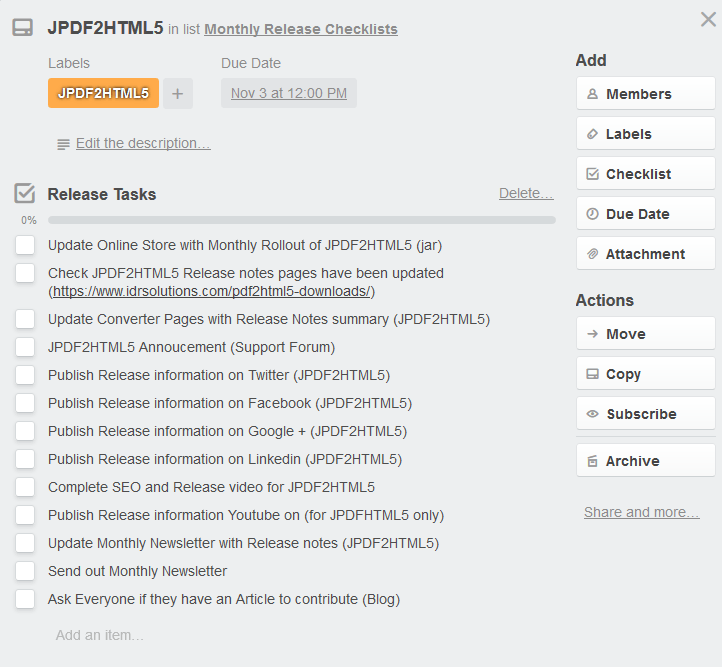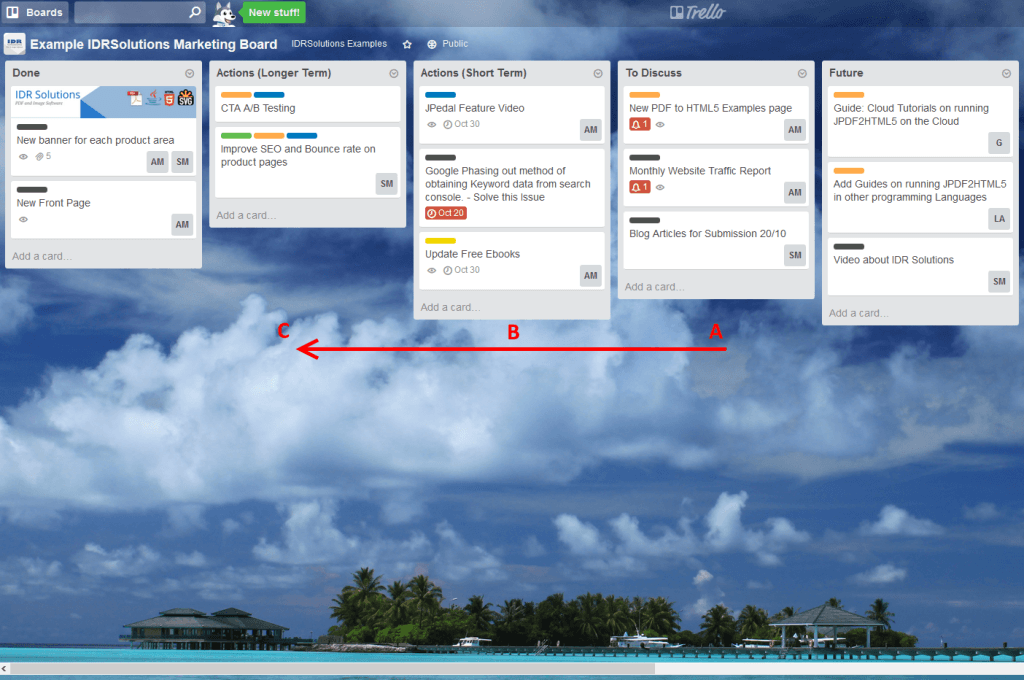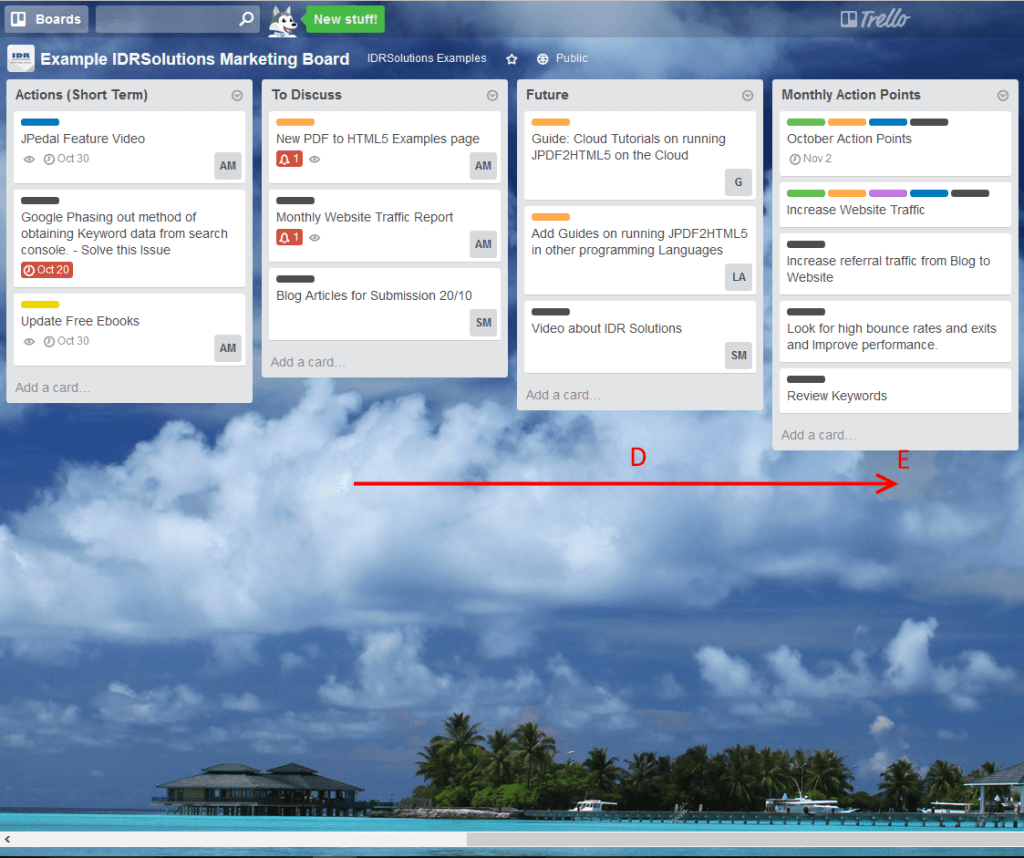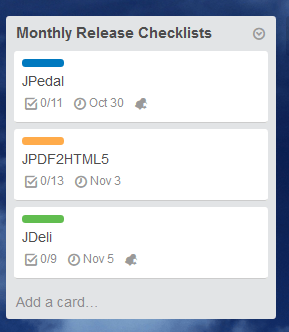We are big fans of Trello at IDR Solutions and I am a big fan as I use Trello a lot in my personal life. Previously we discussed how we use Trello as a tool to manage Sprints for Agile and Scrum, and this time I will take you through how we use Trello for managing Marketing.
So what is Trello?
Trello is a online web based project management tool based on the Kanban (かんばん, which translates into signboard) ideology which was heavily popularized in the 1980’s by Toyota and other Japanese companies before being adopted elsewhere.
In terms of how Trello works, projects are represented by boards, these boards then are broken down and contain lists. Within lists are cards that represent tasks. These cards are supposed to progress from one list to the next, mirroring the progress flow of the aforementioned task (from idea to implementation for example). Trello lists some good ideas for boards on their website.
So how do you use it?
The Marketing Department and other members of staff meet up on a weekly basis to discuss, plan and monitor our marketing strategy. Some staff are remote, so the great thing is that Trello allows everyone at IDR Solutions to work together in one place, regardless of their physical location.
How to use the Marketing Board
We work from right to left and split our lists into different categories. This allows us to cover a lot of things that need to be closely monitored as part of our marketing.
Let me start on how we use this Trello board. The first main point we start at is:
- A. To Discuss – This List is where we list our ideas that we have or things that need to be discussed perhaps relating to the products or after we have analyzed data from our marketing software, these are listed on cards.
- B. Actions Short Term – This list is where we move our discussed ideas onto. This is only the case if these ideas can be completed within a short period of time such as within a week.
- C. Actions Longer Term – This list is where we move our ideas that have been discussed if the time required to complete this task is longer or if it requires careful monitoring it will be placed on this list. In screenshot you can see one of the suggestions on the card had been to change a CTA (call to action on the website), the effects of this would not be immediate so we would have to wait whilst performance data is collected.
We also work left to right from the ‘To Discuss’ List.
- D. Future – Often items we have discussed can be moved onto this list if it requires a significant period of investment or sometimes it can be considered a wish list item. Some items are considered to have a lower priority and would eventually move onto the Longer Terms actions.
- E. Monthly Action Points – On a monthly basis we produce a monthly report of traffic for IDR Solutions and use this to see how our pages on our Java PDF Library, PDF to HTML5 Converter and Java Image Library perform. We review our monthly report and add points to be discussed and these are eventually moved to this list.
Finally we have a Done list.
The Done list is where we move cards to after we have completed the task. This list is reviewed at the next Marketing meeting where a next point of action can be decided (ie should we close the card or should we monitor again?)
Labels, Due dates & Members
 Each card on this board has a label associated with a product, so if we have a specific action related to a particular product this label will be used to signify this.
Each card on this board has a label associated with a product, so if we have a specific action related to a particular product this label will be used to signify this.
Due dates are used to signify when we expect that this task to be completed and members are used to signify who we expect to carry out that particular task.
An Independent List
On the Marketing Board we have a list that may look out of place as it operates independently from the other cards.
This list is related to our Monthly Release Checklist.
The cards on this list contains tasks that need to be completed once the rollout of our software has been done (see this article for more information on this). The cards on this list contain a checklist of tasks that need to be completed to promote the software release. An example below shows what you will find in this list, which includes publishing our release information on our release notes page, downloads page, on Social Media or in our Newsletter.

Conclusion
At first Trello can be a little daunting to use especially if you are not used to doing ‘To do lists’, or like to use the old fashion pen and paper list. I have found that its easier to visualize things to discuss and also clearer to show how something may or may not work in terms of ideas and statistics. Having a board that we can collaborate on is useful as often marketing ideas can come from developers too, so it is easier to communicate with other members of the team and keep them informed, ensuring that the developers and the marketing team works tightly together.
You can view our Example Marketing Board here. I hope you found this insight into how we use Trello for Marketing useful, how do you use Trello?
If you have not used Trello yet, why not give it a try.
Our software libraries allow you to
| Convert PDF files to HTML |
| Use PDF Forms in a web browser |
| Convert PDF Documents to an image |
| Work with PDF Documents in Java |
| Read and write HEIC and other Image formats in Java |



take a look at plusfortrello.com for a free opensource plugin for trello for scrum. make reports (even offline), measure spent vs. estimates and a lot more!
Hi Alex, great article thanks! Lately, I came across Nutcache, it’s pretty similar to Trello meaning it also allows you to organize your projects through boards in a kanban fashion, but it also provides you with advanced time tracking and invoicing features. Well worth a look. =)
Todd